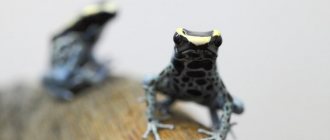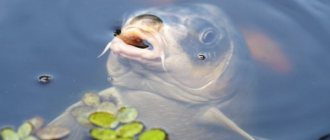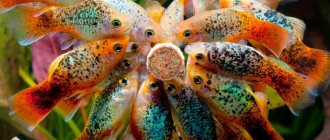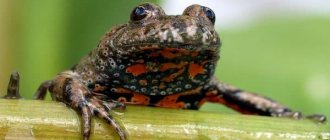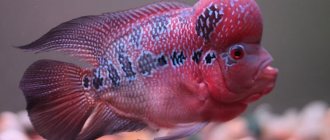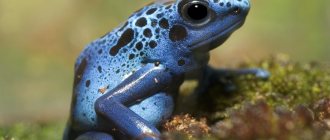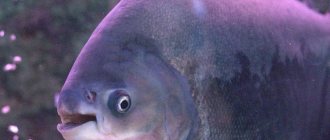The African hymenochirus frog (Hymenochirus boettgeri) lives in the forests of central Africa in bodies of water with standing and low-flowing water: Cameroon, Gabon, Nigeria, eastern Central African Republic and Congo. It is simple in content. Spends almost all its life in water. The dwarf amphibian belongs to the Pipidae family and is a close relative of the well-known clawed frog.
In another way, it is also called the dwarf clawbearer or Böttger's clawbearer in honor of the German zoologist Oscar Böttger.
Description of the frog
The body of Hymenochirus is elongated, the skin is fine-grained, and the legs are thin. The head is slightly pointed. On both sides, at a considerable distance from each other, there are eyes without eyelids. A special feature of this species is the membranes that are clearly visible on the front paws. By the way, this is why the frog was named Hymenochirus, which means “leather-handed.” Body color can be dark gray and gray-brown. Dark brown spots are visible on the upper part. The abdomen is light. An adult grows to 3.5–4 cm in length. Excellent breeding in captivity.
Why put frogs in milk?
Many people know that in the old days it was customary to do this. It was believed that the cold amphibian prevents the heating of the product, and therefore slows down its souring. In the absence of refrigerators, this was completely justified. A similar sanitary and hygienic ritual was practiced not only in Rus', but also in many other European and Middle Eastern countries.
For a long time it was considered a superstition, but the milk really did not turn sour and biologists became interested in the phenomenon. It turned out that the skin of the amphibian has special cells capable of producing natural antibiotics, without which existence in a humid environment, especially in the tropics, would be impossible. Due to fungal and bacterial infections, for which such conditions are heaven on earth, amphibians would not have time to look back before they would be covered with mold. Natural antibiotics also change depending on the habitat. In amphibians galloping along our native shores, they are not so strong, but the peptides produced by the skin have sufficient antimicrobial action to prevent several liters of milk from souring.
Living conditions of the African frog
Considering the small size of the amphibian, a small aquarium is suitable; for example, a couple of individuals can be placed in a 20 liter jar. The acceptable range of water temperature is quite wide - 20-30 degrees, but a temperature of 24-26 degrees, pH 6.5-7.8, gH 5-20, kH 4-15 is still considered comfortable.
The soil for your pet should not be small so that it does not swallow it along with food, but also not very large so that its paws do not get stuck. It is best if it is medium-sized rounded soil. There is no need to create islands of land. The fact is that the dwarf frog can live on land for only 10-15 minutes, and then dies from dehydration.
Use driftwood and stones as decoration. Be sure to plant plants with wide leaves, and put pistia, hornwort, elodea, and duckweed floating on top. But keep in mind that floating plants should under no circumstances cover the entire surface. The Hymenochirus frog swims to the surface of the water every 10 minutes to take a breath of air.
The amphibian does not need frequent water changes. As for the aerator, it's up to you. A filter can be installed, but the stream needs to be very small, since frogs love backwaters. Hymenochirus has delicate skin, so you should use chemicals in the aquarium very carefully. It is also not recommended to pick up your pet.
Coconut or thick bamboo stems are suitable as shelter.
Nutrition
Hymenochirus is not capricious in food and with appetite eats artemia, daphnia, hamarus, coretra, bloodworms, cyclops, earthworms, small boiled pieces of shrimp and mussels, and pellets for bottom fish. Frogs are unable to chew their food, so if necessary, it must be crushed to a size that will fit in their mouth.
Dwarf frogs are fed once every 2-3 days, the main thing is that when kept together with fish, make sure that she gets food. They love to eat and have a tendency to obesity, which is fraught, especially at a young age. In its normal state, the frog looks flat. Food should not be monotonous.
Behavior and compatibility with aquarium fish
Amphibian behavior is very interesting. They are constantly on the move. They love to swim. If kept with fish, they can playfully pluck their fins. This behavior does not cause any harm to the fish. When resting, they sit near shelters at the bottom. During molting, they rub against the ground and shed old skin. There is no need to remove it, as the frog will eat it.
The dwarf frog is compatible with peaceful fish. It gets along well with tetras, glass perches, corydoros catfish, gastromyzons and even shrimp. But predatory and large fish and crayfish will become bad neighbors.
General information.
The African dwarf frog (Hymenochirus boettgeri) lives in the forests of Central Africa. Prefers small standing and low-flowing reservoirs. Dwarf frogs lead an aquatic lifestyle and practically never come onto land. Hymenochirus belongs to the Pipidae family; one of their closest relatives is clawed frogs, popular among terrarium enthusiasts. The word Hymenochirus is translated from Latin as “leather-handed”, in Russian it is sometimes called “claw bearer”, in English african dwarf frog.
Meet the African dwarf frog
Reproduction of dwarf frogs
The differences between male and female may not be noticeable. The female is slightly larger than the male. She has a bulge in the cloaca area, more noticeable than in males. Mature males have white or slightly pinkish glands behind the front legs.
Frogs become sexually mature at the age of 14 months. To stimulate mating, change a third of the aquarium water to fresh water. In this case, the water temperature should be a couple of degrees higher than usual. During the mating season, frogs are well fed. Readiness for mating can be understood by the male’s song and the female’s rounded sides. The male, ready to mate, grabs the female by the waist, and the mating dance begins. The pair rises to the surface of the water, gasps for air and turns belly up. The female lays eggs, and the male fertilizes them. Most often, frogs mate in the evening and at night.
After mating, the frogs are removed. The temperature of the water in the jar is kept within 25 degrees. In such water, after two days, the larvae will hatch and attach to the wall or leaves of the plants for 5 days. After this, you will see tadpoles measuring 3-4 mm in the aquarium. They will actively move around the bank. The babies are fed ciliates, and as they grow, they are switched to nauplii of Artemia and cut tubifex. While the babies are growing, you need to change the water daily and keep the aquarium clean. After 1.5 months, the tadpole will become a small frog about 14 mm long.
The proximity of Hymenochirus with other inhabitants of the aquarium
Since these frogs are small in size and have a calm disposition, they get along well with various small and non-predatory fish. In a community aquarium, Hymenochirus swim slowly, and if you frighten them, they immediately try to hide at the bottom. Therefore, it is worth taking care of the presence of shelters, for example, flower pots or hollow driftwood.
AXOLOTL: CONTENT, CARE, BREEDING, COMPATIBILITY, DESCRIPTION, FEEDING, PHOTO, VIDEO
CULLED FROG: CONTENT, CARE, BREEDING, COMPATIBILITY, PHOTO.
AQUARIUM FROGS: CONTENT, CARE, COMPATIBILITY, BREEDING, DESCRIPTION.
Noblela
This frog is very difficult to spot. Noble species was discovered in 2008. Habitat: southern Peru, Andes. In addition to their miniature size - body length does not exceed 12.5 mm, they have a camouflage color. Dark green “bugs” are very difficult to see on tree leaves or in the grass.
These frogs do not leave their “homeland”. They live in one place all their lives, unlike representatives of other species. Another difference is that Noblela embryos are immediately ready for a full life on earth; they do not become tadpoles.
Appearance
The frog has a large and flat head, on the side of which there are bulging eyes. Along with other land vertebrates, frogs have upper and lower eyelids. Under the lower eyelid of the amphibian, a nictitating membrane is found, which is called the “third eyelid”. Behind the eyes of an amphibian there is a special area covered with thin skin called the eardrum. Two nostrils with special valves are located above a huge mouth with small teeth.
The frog's front legs are characterized by the presence of four rather short toes. The hind legs of the animal are strong and well developed, equipped with five fingers, the space between which is covered with a specially leathery membrane. There are no claws on the animal's fingers. The only excretory part is located in the posterior region of the frog's body and is represented by the so-called cloacal opening. The frog's body is covered with bare skin, quite thickly lubricated with special mucus, which is abundantly secreted by the animal's numerous special subcutaneous glands.
The size of an adult frog varies markedly depending on the species, but most often varies between 0.8-32 cm. The color of the skin is also very diverse and can be brownish, yellow, green or an unusual variegated color. Many members of the family prefer to camouflage themselves with herbaceous vegetation, foliage or branches, and therefore have characteristic green, gray and grayish-green skin.
War coloring, as a rule, indicates that the frog is poisonous, which is explained by the presence of special glands on the skin that produce substances that are toxic and harmful to human or animal health. Some frogs easily mimic, imitating dangerous amphibians to escape from enemies.
Sexual differences and reproduction
The process of reproduction of frogs, which is carried out by specialists, looks interesting. More precisely, they create comfortable conditions for amphibians in captivity. Amphibians will not reproduce in conditions that are not suitable for them. During the period when mating occurs, you need to replace the fluid 2-3 times a week. Make the water a little warmer than usual.
Distinct black stripes will appear on the male’s paws, and he will make a sound that means “combat” readiness. The pair must be placed in a spawning tank with the necessary substrate and clean water. And when the eggs are laid, the couple will go back to the aquarium. There are from 50 to 200 eggs in the clutch; the tadpoles that emerge from the eggs are no more than 3 mm in size.
The frog offspring are fed with rotifers and ciliates. Frogs mature only at the end of the first year of life.
To determine their gender, you can use the following instructions.
- Even in the pet store, take a closer look at all the individuals. The female's body usually widens noticeably towards the pelvis, while the male's body expands evenly along its entire length. There will be no sharp differences in color.
- Take the amphibian in your hands, turn it on its back: if there is a tubercle between the legs that looks like a tail, this is an ovipositor, only females have it. It can be used to distinguish a female from a male.
- You can also examine the throat of the amphibian. Males have resonators that resemble inflating sacs. In some species they are located on the throat and are called throat resonators, in others - on the head, on the sides. Resonators help them make calling sounds during the mating season.
- The amphibian's paws can also be seen. Males will have growths on them that look like a black brush, they stretch straight to the muscle cavity. Or there may be calluses on the paws that look like rough white skin.
But only an expert can determine with a 100% guarantee whether it is a male or a female. In young individuals, sex determination is extremely difficult.
The following video will tell you about the dwarf aquarium frog.
What can they get sick with?
Like any living creature, a white frog can “catch” some kind of disease.
- First of all, your funny and active resident can get parasites. They are the ones who make the skin rough and thin. In addition, it will peel off, and the pet will begin to get sick and lose weight.
- A fungus may appear on the frog. Most often it begins with a sore on the skin, but then can grow throughout the body.
- There may be bacterial infections that can cause visible bruising on the body.
- The most amazing of the existing misfortunes is the swelling of the toad. This is called dropsy, from such an ailment the creature can even become round.
- If the conditions are not suitable for keeping these animals, they may become obese.
To get rid of such diseases you need to use means that are used to treat fish in tropical climates. The main thing is to choose the right drug so that it is specifically against fungi, parasites or bacteria. If we talk about dropsy, you can simply pierce the skin.
A sick frog should be separated from the rest and only then, in quarantine, treatment should be carried out.
In any case, even with these possible options, the creature itself is quite resilient, and recovery will come quickly.
You can learn how to grow a frog from eggs by watching the video below.
Compatibility
Not all species can be kept with other animals. Consider the temperament, activity, conditions for frogs and other animals.
Most frogs prefer stagnant water without strong filtration or currents. Some fish species will not survive in such an environment.
Spurs should not be housed with small and inactive fish.
Hymenochirus gets along with inactive, calm fish, but too active fish species will put it into a stressful state. Do not add labyrinthine fish to Hymenochirus. Amphibians coexist well with shrimp and non-predatory turtles.
Feeding
Ornamental aquarium frogs - both xenopus and hymenochirus - prefer live food.
For spurs, these can be mealworms and earthworms, crickets, large bloodworms, fry and tadpoles. You can give pieces of liver, meat, fish, and shrimp using tweezers.
Claw frogs should not be fed with tubifex, pork, or fatty beef.
Hymenochirus are fed with small bloodworms, live daphnia or fish. Dry and still food is usually ignored by frogs. Adult xenopus and hymenochirus should be given food twice a week.
The feeding behavior of representatives of these two species of frogs also differs. Spurs have an excellent sense of smell, in addition, they have a very developed sense of touch (receptors are pits located on the sides of the frog and reminiscent of the lateral line of fish). Therefore, frogs are good at detecting odors and the slightest movements of water, quickly finding food and greedily pouncing on it.
Hymenochiruses usually need to bring food directly to their nose. You can train them to feed in a certain place or according to a certain signal (for example, tapping with tweezers), but they will take a long time to get to the food, as if thinking along the way whether it is worth doing this at all.
Xenopuses are extremely voracious and therefore prone to obesity; accordingly, the amount of food they eat must be strictly controlled - a healthy frog must remain flat.
https://youtube.com/watch?v=32aTKfVr3Ck
2. Rhombophryne proportionalis
A common name for several species of frogs. They live exclusively in Madagascar. There are about 23 species of Rhombophryne proportionalis , although there is no information about 4 of them.
“Diamond” frogs have very modest body sizes (length up to 12 mm) and a variety of colors. Little is known about the animals, but scientists are studying them. So, in 2021, 5 new species of these frogs were discovered.
Cuban whistler
Cuban whistlers are the pride of Cuba, endemic (a specific part of the flora or fauna that lives in a certain area). Their body length reaches 11.7 mm, females are slightly larger than males. Color varies from brown to dark brown. Two bright stripes (yellow or orange) run along the body.
Frogs are diurnal. Their name speaks for itself - they are excellent singers. The diet consists of ants and small beetles.
The number of Cuban whistlers is gradually decreasing. If this continues, the species will be in danger of extinction. The habitat is shrinking. Natural biotopes are replacing coffee plantations and pastures. Some of the frogs' habitats are protected, but they are negligible.
Terrible leaf climber
It is not for nothing that the frog received such a name. It is one of the top most poisonous animals on Earth and can even kill an elephant. It is enough to touch a frog to get fatal poisoning. However, their color is quite bright, as if they warn others about danger.
These are small animals of bright yellow color. Body length is from 2 to 4 centimeters. Terrible leaf climbers are found only in southwestern Colombia. They choose the lower tiers of tropical forests, lead a diurnal lifestyle, and are quite active. Their diet is no different from the diet of other frogs.
They can be kept in captivity; without the necessary food, they lose their poisonous properties. On the territory of our country, keeping leaf climbers is prohibited by government decree.
Species of amphibians
There are thousands of species of amphibians in nature, but not every toad or frog can be kept in an aquarium. No more than 15 species have adapted to life in artificial conditions and even reproduce in captivity.
At the same time, only the clawed frog, Hymenochirus and some others are recommended for keeping in home aquariums.
African Hymenochirus
The African dwarf frog Hymenochirus boettgeri lives in swampy lakes and oxbow lakes, where the water is very stagnant. When kept in captivity, the water in the aquaterrarium should be changed as rarely as possible.
These pets do not require additional aeration of the liquid. Thus, it is difficult to select fish that could live in such conditions and coexist with amphibians.
These are small creatures: their body length reaches 3-4, sometimes 6 cm. The animals have an elongated muzzle and long strong paws. There are translucent membranes between the fingers.
- Hymenochiruses often use their forelimbs to push food into the throat.
- Their skin is thin, with faint pimples. Its color can vary from marsh to burgundy.
- African frogs are not aggressive and lead a hidden lifestyle. They spend most of the day hiding in dense thickets of aquatic plants.
- It is advisable to equip them with several shaded places where amphibians could retire.
Xenopus (clawed frog)
Xenopus was described in 1802 and has already become the most common domesticated species among amphibians. Individuals living in nature are distinguished by a marsh-brown skin color, but under artificial conditions varieties of yellow, white, light green and beige colors have been obtained.
- Claw frogs have a flat, short snout with large, bulging eyes, but they see almost nothing. Their upper eyelid has become a fold of skin. Xenopus rely more on their sense of smell.
- The body length of these amphibians reaches 8-10 cm. If favorable conditions are created for pets, they can grow up to 14 cm. The front legs are thin and small. At the same time, the hind pair of limbs is well developed.
There are transparent membranes between the long fingers. Frogs spend most of their lives underwater, periodically rising to the surface for a breath of air. These slippery creatures absorb large amounts of oxygen through the pores of their skin.
Xenopuses are omnivores, but they need to be fed in moderation, because... they are often obese. These large frogs are active in the aquarium, often digging up plant roots and moving stones. Clawed frogs are unclean and often muddy the water, since such conditions are most comfortable for them. Keeping with fish is conditional due to the fact that the frog is predatory.
Sex of the clawed frog
Frogs do not show sexual characteristics until they are nine months old. Females are usually larger than males and have a tail-like ovipositor and they do not make sounds. Males are smaller and thinner, there is no ovipositor and, unlike females, they sing (make sounds).
The clawed frog sings
Uki (bellied toads)
The most commonly kept fire-bellied toads in home aquaterrariums are yellow-bellied and red-bellied. These creatures are brightly colored and poisonous. The toxic substance they produce is not dangerous to humans, but you must wash your hands after contact.
- The yellow-bellied water frog has a beige back with many dark stripes. The abdomen is yellow with black streaks.
- The red-bellied duck has a green back with black spots. The abdomen is red with a large number of large round spots, some of them merge. The body length of the animals reaches 7 cm. Toaded toads are able to remember the faces of their owners and approach the wall of the aquarium, waiting to receive food.
These creatures are undemanding to the cleanliness of their habitat. However, you can only add settled tap water to the container to reduce the chlorine content in it.
It is not recommended to keep toadstools with fish, because These amphibians are not clean, often muddy the water and undermine plants, which can lead to the death of other inhabitants of the artificially created environment.
Surinamese pipa
The Suriname pipa is neither a frog nor a toad, but a separate species of amphibian.
The peculiarity of these creatures is their strongly flattened shape. Their nose is pointed. The skin is rough and wrinkled.
Its color can be gray, pink, beige. The back is darker than the belly. There may be black spots on it.
Each front paw is crowned with four long toes. The hind legs have webs. Peeps lack tongue and teeth. Body length reaches 12 cm.
Reproduction of pips at home is very difficult.
They reach sexual maturity at 6 years of age. First, the couple dances a special dance underwater. This may take several days. Subsequently, the female, without leaving the aquatic environment, lays several eggs, and they are immediately enveloped in white sperm released by the male.
Then the next batch is released. The total number of eggs in a clutch can range from 40 to 144 pieces. The female presses the fertilized eggs to her back, distributing them into the existing cells.
Tadpoles feed on mucus secreted by the mother. Only after 12 weeks do formed small peeps appear from under the mother’s skin. In nature, these animals live in the murky waters of slow-flowing tributaries of the Amazon. When keeping them at home, they need to create similar conditions.
Paedophryne amauensis
Habitat: Papua New Guinea. Endemic. Tiny tailless animals, their body length does not exceed 8 mm, they are no larger in size than a grain of rice. They live in the forest floor of tropical forests; thanks to their camouflage color, it is simply impossible to notice them. Colors – dark brown, brown.
Paedophryne amanuensis was identified relatively recently, in 2009, by ecologist Christopher Austin and graduate student Eric Rittmeyer. The frogs discovered themselves with a loud chirping sound that sounded more like the sounds made by insects.
Paedophryne amanuensis is currently the smallest vertebrate in the world. Although scientists believe that the fauna of New Guinea has not yet been fully studied, and over time many more interesting things can be found there. Who knows, maybe soon the record of these frogs will be broken?
2 1
Growing conditions
It’s difficult to say that aquarium frogs are the cutest creatures. Fish are cleaner and less aggressive than amphibians. But lovers of wildlife, who are ready to organize mini-ecosystems at home, prefer to have frogs instead of silent fish (or together with them). Out of great love for zoology, you can join the ranks of the owners of such unusual pets and care for them.
Interestingly, the clawed frog, ready to become your pet, is the first vertebrate that has been cloned. And another interesting fact: about 100 years ago, the clawed frog was used as a pregnancy test. If you inject her with pregnant urine, she will begin spawning under the influence of hCG.
Because frogs are interesting zoological objects, many people do not view amphibians as living aquarium toys. They are serious about keeping amphibians, caring for them, and making observations. And they carefully study all available information in order to allow the underwater inhabitant to live a completely comfortable and happy aquarium life.
Requirements for an aquarium
If you are keeping a couple of large frogs, then the approximate volume of the aquarium should be about 100 liters. The tank needs good filtration and low aeration. The toaded toads will live in an aquaterrarium - a special device. A couple of adult toads should expect a tank of at least 5 liters.
For Shportsevs, 10-20 liters is enough for two. There must certainly be enough hiding places in the aquarium, because this species prefers reclusiveness to a “secular” lifestyle.
Water
The basis of proper preparation is to let the liquid settle for 3 days, this reduces the amount of chlorine in it. Amphibians are unpretentious to the level of acidity and water hardness. Experienced aquarists advise not to pour it out when changing the water in the tank. The water that has been settled and drained from the sediment is suitable for filling a fish tank. The water temperature is quite high - from 22 to 28°C for different types of amphibians.
Priming
Large pebbles will be required as soil for popular species of aquarium inhabitants. For American pipa, fine gravel will also be suitable. Fire-bellied toads like sand and clean gravel, while toaded toads prefer pebbles.
Plants
Plants, if present in the aquarium, can only be hard-leaved. They can only be planted in pots, otherwise the frogs will quickly start digging. It’s good if the plants form entire thickets in the water house, the frogs will like to hide behind them.
It should be noted that frogs, like all living beings, are susceptible to disease. Some diagnoses of aquarium amphibians are quite common.
- Nematode infection. Amphibians become gray, rough, and their skin peels off. They lose weight very quickly, and when scraping the skin, you can actually notice millimeter-sized worms.
- Fungal diseases. More often, the fungus affects injured areas of the skin, where a cotton-like coating is formed that can move throughout the body.
- Red paw. This is the name for a bacterial infection that causes red spots to appear on the frog’s legs and face.
- Dropsy. Another bacterial infection, in which the amphibian swells like a balloon, swells, and the body loses its usual contour.
Frogs are treated with products for tropical aquarium fish, selected according to the causative agent of the disease. If there are several frogs in the container (or they live with fish), the sick pet will have to be isolated. Obese frogs and pets living in uncomfortable conditions are more susceptible to diseases.
Care and maintenance
You will need to regularly take care of the habitat of such creatures, because due to their nature, white frogs often dig the soil, which causes clouds of sand in the water. But none of their representatives are picky about their living conditions, and therefore you can safely keep them in any aquarium, but preferably one with a volume of at least 20 liters.
In order for your residents to feel comfortable, do not fill the aquarium completely with water - it is worth leaving some oxygen .
The best option would be to fill the container two-thirds full.
It is highly advisable to close the aquarium from above, since its very active inhabitants can jump out. It is worth putting pebbles at the bottom; pebbles are the best option. The water will need to be filtered, but be sure not to create too much current, otherwise it will be difficult for the frogs to swim. As for lighting, there are no preferences in this regard; it is not at all necessary to have bright light sources.
About the water temperature: quite similar to the room. In this case, the ideal would be about 23 degrees. If you draw water from the tap, you must first let it sit for about 3 days. Change this water at least once a week for a quarter of the total amount.
If you plan to plant plants, then use only pots, because, as already mentioned, if you try to plant directly in the ground, the frogs will immediately dig everything up. You can also place pots of plants next to the aquarium and only submerge small areas in the water.
So the water will not quickly become polluted, and no harm will be done to the plant.
Behavioral characteristics of pets
Frogs are among the most ancient species of amphibians, appearing on the planet long before dinosaurs, so watching them is no less interesting than colorful aquarium fish.
These creatures are not primitive. They have a good memory and are able to remember the faces of their owners and even treat people differently. Frogs and toads, if given food on a schedule, will approach the place where they can get food at the right time.
Species affiliation influences the behavior of these animals. Large frogs are often aggressive, digging through and tearing up algae, moving decor, etc.
Such individuals have difficulty getting along with fish and other inhabitants of the aquarium, and may even perceive their “neighbors” as food. It is better to keep them in a separate aquaterrarium only with their relatives.
Dwarf species have a more docile character. They rarely damage decor and plants and pollute their habitat less intensively.
These creatures are slow, so they can often be seen sitting on the bottom of an aquarium or on a piece of land. Attempts to hide in dense thickets of aquatic plants are the norm for them.
Some pet frogs can make quite loud noises, more often at night. This happens not only during the breeding season.
With the help of piercing sounds, individuals living in the tank maintain social contacts.
